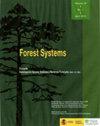砍伐森林的恢复证明,在委内瑞拉瓜亚纳地盾进行可行的管理是可能的
IF 0.7
4区 农林科学
Q3 FORESTRY
引用次数: 0
摘要
研究目的:比较采伐后不同年龄的砍伐森林的多样性和生物量,以及它们退化为藤本林的风险。研究区域:我们研究了委内瑞拉Imataca森林保护区(Guayana shield)中心地带的18个地块。材料和方法:我们使用1-ha地块,在对照地块(0年)和伐木后3、9、12、15和18年的伐木地块中测量dbh>10 cm的个体。评估的主要变量是扩大重要性指数(EII)、丰富度(R)、香农-维纳指数(H´)、阿尔法-菲舍尔(α)、商业物种基底面积(BA_comm)、地上碳(C)和林下藤本植物丰度(藤本植物_%Au)。主要结果:多样性变量(R:62-77 spp ha-1,p:0.117-0.838;H´:2.8-3.4,p:0.181-0.677;α:18.6-25.4,p:0.293-0.922)和生物量(89.6-180.2 MgC ha-1,p=0.171-0.895)在对照和大多数记录地块之间没有显著差异。只有18年树龄的森林具有更高的多样性值(R:81-94 spp ha-1,p:0.000;H´:3.8-3.9,p:.000;α:26.8-31.7,p=0.000),这可能是由于高冲击打滑操作。商业物种在砍伐后没有恢复。研究重点:该地区的森林管理是可行的,但它需要减少影响的伐木技术和更好的造林系统,以确保未来收获高价值的商业木材。本文章由计算机程序翻译,如有差异,请以英文原文为准。
The recovery of logged forests proves that a viable management is possible in the Venezuelan Guayana Shield
Aim of study: To compare the diversity and biomass of logged forests, with different ages after harvesting and the risk of their degradation to liana forests.
Area of study: We studied 18 plots at the central zone of the Imataca Forest Reserve (Guayana shield), Venezuela.
Material and methods: We used 1-ha plots, to measure individuals with dbh > 10 cm in control plots (0 years) and in logged plots with 3, 9, 12, 15 and 18 years after logging. The main variables evaluated were enlarge importance index (EII), richness (R), Shannon-Weaner index (H´), Alpha Fischer (α), basal area for commercial species (BA_comm), above-ground carbon (C) and lianas abundance at the understory (Lianas_%Au).
Main results: Diversity variables (R: 62-77 spp ha-1, p: 0.117-0.838; H´: 2.8-3.4, p: 0.181-0.677; α: 18.6-25.4, p: 0.293-0.922) and biomass (89.6-180.2 MgC ha-1, p: 0.171-0.895) did not have significant differences between control and most of the logged plots. Only the 18 years-old forests had statistically higher values of diversity (R: 81-94 spp ha-1, p: 0.000; H´: 3.8-3.9, p: 0.000; α: 26.8-31.7, p: 0.000), perhaps due to a high impact skidding operation. Commercial species were not recovering after logging.
Research highlights: Forest management can be viable in this area, but it requires reduced impact logging techniques and better silvicultural systems to guarantee future harvest of high value commercial timber.
求助全文
通过发布文献求助,成功后即可免费获取论文全文。
去求助
来源期刊

Forest Systems
FORESTRY-
CiteScore
1.40
自引率
14.30%
发文量
30
审稿时长
6-12 weeks
期刊介绍:
Forest Systems is an international peer-reviewed journal. The main aim of Forest Systems is to integrate multidisciplinary research with forest management in complex systems with different social and ecological background
 求助内容:
求助内容: 应助结果提醒方式:
应助结果提醒方式:


